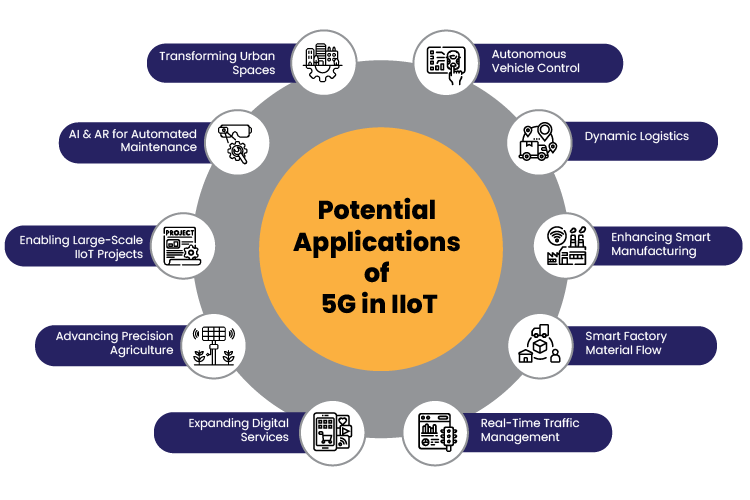

ACL Digital
5 Minutes read
The Role of 5G in Enhancing Industrial IoT Use Cases
5G, the fifth generation of mobile communications, is set to revolutionize connectivity, offering speeds up to 20 times faster than 4G, with latency reduced from 50 milliseconds to under 1 millisecond, and significantly increased bandwidth to handle vast amounts of data simultaneously. While its impact on consumer devices like smartphones is transformative, 5G’s real potential lies in its role within Industry 4.0 and the Industrial Internet of Things (IIoT). According to industry projections, the global 5G in IIoT market is expected to reach $3.7 billion by 2026, growing at a CAGR of over 70% as industries embrace its capabilities.
This cutting-edge technology goes beyond mobile networks, enabling seamless communication between devices, systems, and processes in industrial and service sectors. With the support of 5G, smart factories, cities, and mobility initiatives are poised to become more efficient and connected. For example, 5G’s low latency and high bandwidth enable real-time data processing in automated guided vehicles (AGVs), predictive maintenance, and AR/VR solutions. By empowering IIoT implementations, 5G opens new frontiers to improve productivity, efficiency, and operational effectiveness, setting the stage for a fully connected, data-driven industrial ecosystem.
Transforming Industrial Operations with IIoT and 5G Integration
The 5G industrial Internet is set to revolutionize every aspect of connected facilities. Before diving into the specific advancements brought by 5G, let’s first explore how IIoT benefits industrial operations—regardless of its speed 4G or 5G.
Optimized Performance Monitoring
Connected IIoT sensors provide detailed insights into equipment performance and health, identifying early warning signs such as temperature or vibration anomalies. This proactive approach prevents disruptions and ensures efficient maintenance planning.
Remote Operational Access
In today’s dynamic landscape, remote operations are critical. IIoT hardware and software enable seamless equipment monitoring and control from any location, allowing uninterrupted workflows even during crises like COVID-19.
Enhanced Automation
IIoT technology supports automation by delivering rich data to AI systems, helping optimize processes and improve productivity. This data-driven approach enhances operational efficiency and workforce flexibility.
Streamlined Maintenance
Real-time performance data allows for predictive maintenance strategies, minimizing unplanned downtime and reducing the risk of costly shutdowns.
Improved Workplace Safety
With better machine performance and predictive maintenance, IIoT ensures safer facilities by reducing unexpected incidents.
Smart Factory Integration
IIoT enables harmonious collaboration between workers, robots, and automated systems, creating more efficient production environments.
The Role of 5G in Elevating IIoT Capabilities
- 5G’s increased bandwidth enables high-definition video monitoring and multi-stream capabilities, eliminating the need for hardwired systems while ensuring superior performance from any location.
- With response times as low as 1 millisecond, 5G delivers near real-time monitoring and control, crucial for sensitive industrial processes and maintenance tasks.
- 5G ensures uninterrupted connectivity, eliminating the risks of system downtime and boosting the reliability of IIoT infrastructure.
- The broader bandwidth of 5G supports multiple access channels, including simultaneous high-definition video streams, enhancing safety and operational efficiency through redundancy.
Potential Applications of 5G in IIoT

Autonomous Vehicle Control
5G’s low latency allows autonomous vehicles to react up to 100 times faster, enhancing safety by reducing braking distance and supporting real-time communication crucial for semi-autonomous driving. As 5G continues to evolve, it is expected to bring fully autonomous driving closer to reality, paving the way for safer roadways.
Real-Time Traffic Management
Intelligent traffic systems using 5G can analyze and control traffic via sensors, traffic lights, and radar, improving the flow and safety of multimodal transport systems, particularly in logistics. This ensures smoother commutes and allows cities to reduce congestion through predictive traffic control.
Dynamic Logistics
5G’s connectivity enables logistics systems to adapt instantly to traffic and weather, optimizing routes and delivery times while minimizing delays and resource consumption. By providing real-time updates, 5G helps fleet managers optimize efficiency and reduce operational costs.
Enhancing Smart Manufacturing
5G allows continuous data collection in manufacturing through image processing and smart workstations, enabling automated analysis for improved efficiency and sustainability. This data integration supports predictive maintenance, minimizing unexpected downtime and maximizing production capacity.
Smart Factory Material Flow
With 5G, mobile warehouses and sensor-equipped workstations can track and adjust material flow dynamically, helping reduce resource use and carbon footprint in production processes. The streamlined material flow contributes to a greener, more efficient manufacturing environment.
AI and AR for Automated Maintenance
AI-based solutions using 5G and AR devices like data glasses facilitate assisted maintenance, providing real-time insights and remote support for plant upkeep. Technicians can conduct virtual inspections and access critical data instantly, reducing maintenance costs and improving safety.
Transforming Urban Spaces
Smart cities leverage 5G for intelligent traffic, efficient building management, and comprehensive healthcare access, boosting quality of life through digital urban and rural infrastructure. These integrated systems help cities become more sustainable, resilient, and responsive to residents’ needs.
Advancing Precision Agriculture
5G supports precision farming by connecting data-driven tools that help optimize land use, enabling sustainable agricultural practices and improving productivity through real-time data exchange. Farmers benefit from data-driven insights for crop management, leading to improved yields and resource efficiency.
Expanding Digital Services
5G enables the digitalization of rural areas, supporting a range of services from local supply chains to healthcare, and closing gaps in connectivity for comprehensive regional development. This connectivity strengthens rural economies and improves access to essential services, enhancing quality of life.
Enabling Large-Scale IIoT Projects
With 5G, the enormous data demands of IIoT in areas like smart cities, smart farming, and logistics are manageable, bringing ambitious real-time connected applications within reach for the first time. This innovation paves the way for widespread IIoT adoption, transforming industries and communities alike.
Conclusion
5G is not just an upgrade in connectivity; it is the cornerstone of a new era in industrial transformation. By unlocking the full potential of IIoT, 5G empowers industries to operate with unprecedented efficiency, agility, and precision. Its low latency, high bandwidth, and enhanced reliability make real-time data processing, predictive maintenance, and automation seamless, while enabling advanced applications like smart cities, autonomous vehicles, and precision agriculture. As industries embrace 5G, they pave the way for a fully connected, data-driven future that revolutionizes how we produce, move, and live.
For the latest updates or additional information, feel free to contact ACL Digital.



